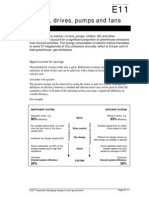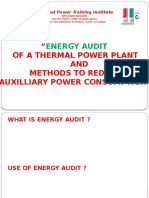Auxiliary Power Consumption
Auxiliary Power Consumption
Uploaded by
Abdulyunus AmirCopyright:
Available Formats
Auxiliary Power Consumption
Auxiliary Power Consumption
Uploaded by
Abdulyunus AmirOriginal Description:
Copyright
Available Formats
Share this document
Did you find this document useful?
Is this content inappropriate?
Copyright:
Available Formats
Auxiliary Power Consumption
Auxiliary Power Consumption
Uploaded by
Abdulyunus AmirCopyright:
Available Formats
ENERGY AUDIT OF AUXILIARY POWER CONSUMPTION
ATAR SINGH Dy. DIRECTOR NPTI FARIDABAD
Energy Conservation in Power Utility
Power plant produces electrical energy
and also consumes a substantial amount of energy in the form of auxiliary consumption required for various plant equipments and services
Energy Conservation in Power Utility
Achieved mainly by:
Operating the equipments at maximum efficiency and Reduction of auxiliary Power consumption
The auxiliary power consumption (APC) varies from 6-14% ,
depending on Size of plant ,use of TDBFP &age of plant The 500 MW units register the least APC, largely due to the incorporation of TDBFP. In some of the old 110 MW plants, APC consumption of 14% is also observed. Energy audit in a vast thermal power station (TPS) is better tackled when the thermal power plant operations are segregated into different sub-areas like: main plant auxiliaries, draft system (consisting of ID/FD/PA fans), feed water system [consisting of Boiler Fed Pumps (BFPs) / Condensate Extraction Pumps (CEPs), Circulating Water (CW) system-including Cooling Tower (CTs)], and off sites (consisting of coal handling plants, ash handling plants, air compressors, AC plants, station lightings etc.).
APC Scenario In India
Auxiliary Power Consumption in Thermal
Power Plant is major source of energy consumption. During the financial year 2007-08 total generation by coal plant was 488157.46 MUs with PLF 78.75. Auxiliary Power Consumption was 8.17%. If this APC gets reduced only by 0.17% then it is equivalent to fresh capacity addition of 120 MW without any investment.
Trombay Station of Tata Power Co. Ltd achieved lowest
auxiliary power consumption (4.30%) in the country. Among Central Sector Stations, Talcher STPS of NTPC achieved the lowest auxiliary power consumption (5.34%).
Among State Sector Stations, Chandrapur STPS of MAHAGENCO achieved the lowest auxiliary power consumption (7.40%). Among different capacity groups, the lowest auxiliary power consumption was 6.13% in 500 MW group.
Requirement of works power with load
Factors Affecting Auxiliary Power Consumption
- Unit Generation and load Pattern
- Operation of Plant Auxiliaries - Service auxiliary such as Illumination , air conditioning - Unit Startup / shutdown
STEPS INVOLVED IN CONDUCTING ENERGY AUDIT
Data collection Measurements & Observations Exploration for energy conservation
measures Report preparation
STEPS INVOLVED IN CONDUCTING ENERGY AUDIT
DATA COLLECTION
Motor details requiredID code, Application, Make, Brief details of driven equipment, Type of the Motor, Motor kW, Motor frame, Duty, Rated RPM, Rated p.f., Rated motor efficiency ,Motor make, Motor voltage, Rated current of motor, Year, Operating hours, Energy meter installed or Not times the motor is rewound
, No. of
Collect the above information for all motors to be covered in the energy audit. Collect the motor efficiency curves
STEPS INVOLVED IN CONDUCTING ENERGY AUDIT
Instruments Required Power Analyzer: Used for measuring electrical parameters
such as kW, kVA, pf, V, A and Hz Infrared pyrometer (In case any heating of cable or motor is suspected) Stroboscope: To measure the speed of the driven equipment and motor The above instruments can be used in addition to the calibrated online / plant instruments
STEPS INVOLVED IN CONDUCTING ENERGY AUDIT
Parameters to be measured Energy consumption pattern of motors (daily / monthly
/yearly consumption if available) Motor electrical parameters (kW, kVA, Pf, A, V, Hz, etc.) for individual motors Equipment operational details
While conducting the measurement or performance
evaluation of any system simultaneously, the following need to be noted Unit load of the plant Date & time of measurement Instruments used for measurement Frequency of the measurement
STEPS INVOLVED IN CONDUCTING ENERGY AUDIT
MEASUREMENTSAND OBSERVATIONS
System details
Detailed interactions with the plant personnel
Energy consumption Pattern
If the plant is monitoring the energy consumption, it is suggested to record the data and monitor the daily and monthly consumption pattern
STEPS INVOLVED IN CONDUCTING ENERGY AUDIT
Equipment Annual Consumption MWH Average Load KW % of Total Generation % of total APC
Air Compressors Coal Handling Plant Raw Water pumps DM water pumps A/C systems ESP Total
STEPS INVOLVED IN CONDUCTING ENERGY AUDIT
Equipment Annual Consumption MWH Average Load KW % of Total Generation % of total APC
Boiler Feed Pump Condensate extraction Pump CW Pumps ID Fans FD Fans PA Fans Mils CT Fans
STEPS INVOLVED IN CONDUCTING ENERGY AUD
Total Generation Auxiliary Power Consumption Contribution To APC By Unit 1 % 2.78 0.26 0.22 1.38 1.41 0.74 0.35 0.29 0.26 2.37 Unit 2 MW 4.29 0.43 0.31 2.08 2.38 1.53 0.57 0.47 0.42 4.21
MW 1305.57 111.7 Unit 3 MW 4.52 0.41 0.30 2.34 2.36 1.69 0.57 0.47 0.42 4.11 % 3.39 0.31 0.23 1.51 1.52 1.08 0.36 0.30 0.27 2.64 Unit 4 MW 1.69 1.21 8.18 4.85 2.92 1.11 0.52 0.38 10.28
% 81.60 (of installed capacity) 8.56 (of actual generation) Unit 5 MW 1.78 1.26 7.25 4.82 2.92 1.11 0.52 0.38 10.22 % 0.42 0.29 1.51 1.00 0.61 0.23 0.11 0.08 2.13 Over All MW 13.34 4.73 3.43 22.12 16.72 10.25 3.92 2.45 2.04 32.70 % 1.02% 0.36% 0.26% 1.69% 1.28% 0.79% 0.30% 0.19% 0.16% 2.50%
MW BFP's 4.52 CEP's 0.43 FD's 0.35 ID's 2.26 PA's 2.31 Coal Mills 1.21 CHP 0.57 AHP 0.47 Air 0.42 Compressors Others 3.89 (CWPs, RWPs, DM Plant, etc ) Total 16.42
% 2.98 0.30 0.22 1.44 1.65 1.06 0.39 0.33 0.29 2.92
% 0.45 0.29 2.24 1.34 0.81 0.31 0.14 0.11 2.84
10.06
16.67
11.58
17.18
11.61
31.14
8.53
30.26
6.38
111.70
8.56%
Motor loading survey
Details Rated Kw Rated Efficiency Rated Speed Measurement of parameters Power factor kVA KW drawn Frequency Harmonics Motor speed Driven Voltage Current Power equipment speed Driven equipment parameters Operational observations Transmission % loading on the motor
STEPS INVOLVED IN CONDUCTING ENERGY AUDIT
Motor loading can be estimated by:
Loading =
Input kW to motor x 100 --------------------------------------------------------------------Name plate kW /Name plate full load motor efficiency
STEPS INVOLVED IN CONDUCTING ENERGY AUDIT
While conducting motor load survey,
observations on machine side:
parameters such as speed, load, pressure, temperature, etc., (as relevant) are also taken
availability of load-end capacitors for PF
correction & energy meters for monitoring is also looked into for each case.
STEPS INVOLVED IN CONDUCTING ENERGY AUDIT
Motor Rewinding History
comparison of no load current and stator resistance per phase of a rewound motor with the original no-load current and stator resistance at the same voltage can be one of the indicators to assess the efficacy of rewinding.
STEPS INVOLVED IN CONDUCTING ENERGY AUDIT
Power Factor Correction
Induction motors are characterized by power factors less than unity, leading to lesser efficiency (higher overall operating cost) associated with a plant's electrical system.
Capacitors connected in parallel (shunted) with the motor are typically used to improve the power factor
The impacts of PF correction include reduced kVA drawn , KVAR & current, reduction of transformer load, Reduction of cable losses, reduction of switch gear rating, Enhanced life of equipment
STEPS INVOLVED IN CONDUCTING ENERGY AUDIT
EXPLORATION OF ENERGY CONSERVATION
MEASURES
Replacement / sizing of motors Opting for energy efficient motors, Use of high efficiency motors, Use of energy efficient transmission Replacement of pulleys Direct coupling
STEPS INVOLVED IN CONDUCTING ENERGY AUDIT
Analysis of observations
o
o
Loading pattern % loading Comments of power supply quality
The BIS standards specify that a motor should be capable of delivering its rated output with a voltage variation of 6 % and frequency variation of 3 %. Motor o Identified motors with less than 50 % loading, 50 75 % loading, 75- 100 % loading, over 100 % loading o Identified motors with machine side losses / inefficiencies like idle operations, throttling/damper operations o Motor load survey is aimed not only as a measure to identify motor efficiency areas but equally importantly, as a means to check combined efficiency of the motor, driven machine and controller
AUXILIARY POWER CONSUMPTION
Operating only 4 mills instead of 5 mills in 210 MW units Shutting of CTs cells in conjunction with favorable weather
conditions and replacing existing aluminum cast and GRP blades with FRP
avoiding idle running of conveyors & crushers
incorporating soft starter - energy savers etc.
AUXILIARY POWER CONSUMPTION
STRATEGY
Variable frequency drive for PA Fans & ID Fans & CEPs
Air in-leaks in draft system (O2 measurement) blanketing Replacement of inefficient BFPs as a part of R& M of the old plants. Clipping of one stage from the multi stage BFPs to balance the pressure drop requirements between HP heaters, economizer and boiler drum etc. Use of higher pressure in the deareator to commensurately reduce BFP power consumption (reduced head developed) Running of two CEPs instead of 3 CEPs (3 CEPs are run to avoid tripping due to lower frequency in some of the power plants) Application of variable speed drives Installation of hydraulic turbine instead of feed regulating section to avoid pressure drops and to generate additional power
You might also like
- Heat Rate Monitoring: Soumyajit MukherjeeDocument38 pagesHeat Rate Monitoring: Soumyajit MukherjeentpckanihaNo ratings yet
- CEP - SavingDocument6 pagesCEP - SavingManoj UpadhyayNo ratings yet
- Presented By: Souvanik Chakravorty S Anil Kumar Tatithuri G SrikantDocument30 pagesPresented By: Souvanik Chakravorty S Anil Kumar Tatithuri G Srikants anil kumar tatithuriNo ratings yet
- Apc PPT PDFDocument15 pagesApc PPT PDFrasiganeshNo ratings yet
- Auxiliary Power Consumption Reduction in Thermal Power StationsDocument3 pagesAuxiliary Power Consumption Reduction in Thermal Power Stationsbarun100% (1)
- 03 APC ReductionDocument55 pages03 APC ReductionDevanshu Singh100% (1)
- EEMG Manual RevisedDocument277 pagesEEMG Manual RevisedsridharNo ratings yet
- Aux Power OptimisationDocument18 pagesAux Power Optimisationjp mishra100% (2)
- 2.3 Principle of Turbine Governing CompressedDocument54 pages2.3 Principle of Turbine Governing Compressedabhaymehta67100% (3)
- CMC NTPC UnchaharDocument8 pagesCMC NTPC UnchaharDino100% (1)
- CFBC Boiler Start Up ProblemsDocument40 pagesCFBC Boiler Start Up ProblemsarvindshuklaNo ratings yet
- Thermal Power Plant Performance MonitoringDocument68 pagesThermal Power Plant Performance Monitoringsumit100% (2)
- Aph FireDocument25 pagesAph Firesekhar_ntpcNo ratings yet
- Emergency Procedure For Total Station Power FailureDocument4 pagesEmergency Procedure For Total Station Power FailureSelva Manian100% (2)
- NPTI Publications PDFDocument3 pagesNPTI Publications PDFBalraj SinghNo ratings yet
- Energy Audit Methology For Turbine Cycle - M.V. Pande & Dy - Director PDFDocument33 pagesEnergy Audit Methology For Turbine Cycle - M.V. Pande & Dy - Director PDFtolga ALTINTAŞ100% (1)
- Air Preheater Washing ProtocolDocument3 pagesAir Preheater Washing ProtocolSony Rama0% (1)
- Troubleshooting Coal FeedersDocument3 pagesTroubleshooting Coal Feederssaisssms9116No ratings yet
- CFBC DCPP at A Glance.Document20 pagesCFBC DCPP at A Glance.Sumit SuryavanshiNo ratings yet
- Sop of WHRPPDocument21 pagesSop of WHRPPHaider Ali100% (1)
- Heat Required in Kcal For Unit Generation of ElectricityDocument18 pagesHeat Required in Kcal For Unit Generation of ElectricityAyan Chattaraj100% (1)
- Heat Rate AwarenessDocument32 pagesHeat Rate AwarenessFaltuBhai100% (1)
- CMCDocument32 pagesCMCAnubhav Amu Pandit100% (1)
- Fine Tuning A CFBC Boiler PDFDocument12 pagesFine Tuning A CFBC Boiler PDFrikumohanNo ratings yet
- Boiler Turbine Generator: Unit Trip Report-Draft STPP, 2X600 MWDocument5 pagesBoiler Turbine Generator: Unit Trip Report-Draft STPP, 2X600 MWVishal Kumar Laddha100% (1)
- AUXILIARY COOLING WATER SystemDocument7 pagesAUXILIARY COOLING WATER Systemsambhu100% (2)
- Turbine Performance - STWS - 22-24oct13-1Document50 pagesTurbine Performance - STWS - 22-24oct13-1Gaurav100% (2)
- Flue Gas System-2Document56 pagesFlue Gas System-2Sam100% (1)
- Cep 1Document17 pagesCep 1Nilamani Umashankar Jena100% (2)
- NPTI (SR) Scheme Tracing Report TSIIDocument62 pagesNPTI (SR) Scheme Tracing Report TSIIiwantinthatve75% (4)
- Analysis of Feed WaterDocument9 pagesAnalysis of Feed Watersanju0156100% (3)
- Ing The Starting Device To Zero: M.S. Pr. 35-40 Ksc. HRH Pr. 12-14 Ksc. M.S. and HRH Tempr. - 320 To 3500C)Document3 pagesIng The Starting Device To Zero: M.S. Pr. 35-40 Ksc. HRH Pr. 12-14 Ksc. M.S. and HRH Tempr. - 320 To 3500C)Sourav SahaNo ratings yet
- Combustion Optimization Study in U#2 (By Ex BHEL Boiler Expert M. Somasundaram)Document44 pagesCombustion Optimization Study in U#2 (By Ex BHEL Boiler Expert M. Somasundaram)karikalcholan m100% (2)
- Division - E HP Bypass System Volume - E1 Control Valves, Actuator and Accessories Contents ListDocument150 pagesDivision - E HP Bypass System Volume - E1 Control Valves, Actuator and Accessories Contents ListAnonymous ZnuMEWN1100% (2)
- Coordinate Control System: TurbineDocument5 pagesCoordinate Control System: TurbineGolu kumar100% (2)
- Handling of Turbine During EmergencyDocument17 pagesHandling of Turbine During EmergencyManohar Tatwawadi100% (2)
- Automatic Turbine Run Up System Gyanendra Sharma Npti DelhiDocument47 pagesAutomatic Turbine Run Up System Gyanendra Sharma Npti DelhiNPTI75% (4)
- Aux PRDS SystemDocument22 pagesAux PRDS SystemKhan Ahmed Murad100% (2)
- Power Plant Chemistry For BoeDocument22 pagesPower Plant Chemistry For BoeRamakrishna Chilivery100% (1)
- Heat Rate CalculationsDocument22 pagesHeat Rate CalculationsPankaj Tipramwar100% (2)
- Governing System of 210mw KwuDocument21 pagesGoverning System of 210mw KwuAshok RasekarNo ratings yet
- Major Emergencies in Power PlantDocument29 pagesMajor Emergencies in Power Plantsourav mahapatraNo ratings yet
- CEP Isolation & Normalisation ProcedureDocument2 pagesCEP Isolation & Normalisation ProcedureVishal GuptaNo ratings yet
- Fact Sheet STEAG Power Plant Learning Center India 03Document2 pagesFact Sheet STEAG Power Plant Learning Center India 03sourav mahapatraNo ratings yet
- Sliding PR OperationDocument10 pagesSliding PR Operationrohit_0123100% (2)
- HP HeaterDocument16 pagesHP HeaterDhiraj KumarNo ratings yet
- Poor Vacuum During Initial CommissioningDocument4 pagesPoor Vacuum During Initial CommissioningCharu Chhabra100% (2)
- Sop For Gauge Glass ChargingssDocument2 pagesSop For Gauge Glass ChargingssKUSH SHARMANo ratings yet
- 1#unit Lightup Synchronisation & Shutdown (2) - 1Document42 pages1#unit Lightup Synchronisation & Shutdown (2) - 1Jyoti Prakash PrustyNo ratings yet
- Emergency in Power PlantDocument12 pagesEmergency in Power PlantCo-gen Manager100% (2)
- NTPC - Effiency BookletDocument28 pagesNTPC - Effiency Booklethonchoabhi100% (2)
- Duties & Responsibilities of Shift EngineerDocument35 pagesDuties & Responsibilities of Shift EngineerNaveen Chodagiri100% (1)
- Condenser Graphical AnalysisDocument24 pagesCondenser Graphical Analysissaisrikanths5168100% (1)
- Energy Audit of Auxiliary Power Consumption: Atar Singh Dy. Director Npti FaridabadDocument27 pagesEnergy Audit of Auxiliary Power Consumption: Atar Singh Dy. Director Npti FaridabadHiltonNo ratings yet
- Auxiliary Power Reduction in Thermal Power PlantDocument27 pagesAuxiliary Power Reduction in Thermal Power PlantManoj Upadhyay100% (2)
- Efficiency For Motors and PumpsDocument6 pagesEfficiency For Motors and Pumpsyamaha100% (2)
- Energy Audit PresentationDocument30 pagesEnergy Audit PresentationSikander Girgoukar100% (1)
- Variable Frequency Drives IntroductionDocument11 pagesVariable Frequency Drives Introductionvigneshwaranj87100% (1)
- Manajemen Energi Motor ListrikDocument23 pagesManajemen Energi Motor ListrikJHOSA EITFA ALTISNo ratings yet
- 5.energy Audit of Pumps & FansDocument49 pages5.energy Audit of Pumps & Fanssuppan67% (3)
- Excellent Plan With Bank FDDocument7 pagesExcellent Plan With Bank FDAbdulyunus AmirNo ratings yet
- Activity Based CostingDocument51 pagesActivity Based CostingAbdulyunus AmirNo ratings yet
- Dynamics On Industrial RelationsDocument24 pagesDynamics On Industrial RelationsAbdulyunus AmirNo ratings yet
- CVP AnalysisDocument41 pagesCVP AnalysisAbdulyunus Amir100% (1)
- What Are The Reason A 33kV Bus PT Fuse Is Blowing Out FrequentlyDocument10 pagesWhat Are The Reason A 33kV Bus PT Fuse Is Blowing Out FrequentlyAbdulyunus Amir100% (1)
- Annex I UAT Name Plate 081210Document1 pageAnnex I UAT Name Plate 081210Abdulyunus AmirNo ratings yet
- Combustor InsulationDocument4 pagesCombustor InsulationAbdulyunus Amir100% (2)
- What Does Regenerative Air Pre-Heater Means, Why They Named SoDocument10 pagesWhat Does Regenerative Air Pre-Heater Means, Why They Named SoAbdulyunus AmirNo ratings yet
- What Are The Criteria For Selection of Non Metallic Expansion Joint (NMEJ) and Metallic Expansion Joint (MEJ)Document3 pagesWhat Are The Criteria For Selection of Non Metallic Expansion Joint (NMEJ) and Metallic Expansion Joint (MEJ)Abdulyunus AmirNo ratings yet
- Voltage Management A Hidden Energy Efficiency ResourceDocument3 pagesVoltage Management A Hidden Energy Efficiency ResourceAbdulyunus AmirNo ratings yet
- Utility ICS Current Practices Survey 2013Document13 pagesUtility ICS Current Practices Survey 2013Abdulyunus AmirNo ratings yet
- Top 100 Engineering Interview QuestionsDocument11 pagesTop 100 Engineering Interview QuestionsAbdulyunus Amir100% (1)
- Voltage and Current UnbalanceDocument2 pagesVoltage and Current UnbalanceAbdulyunus Amir100% (1)
- Three Phenomenons in The Iron of AC MachinesDocument4 pagesThree Phenomenons in The Iron of AC MachinesAbdulyunus AmirNo ratings yet









































































